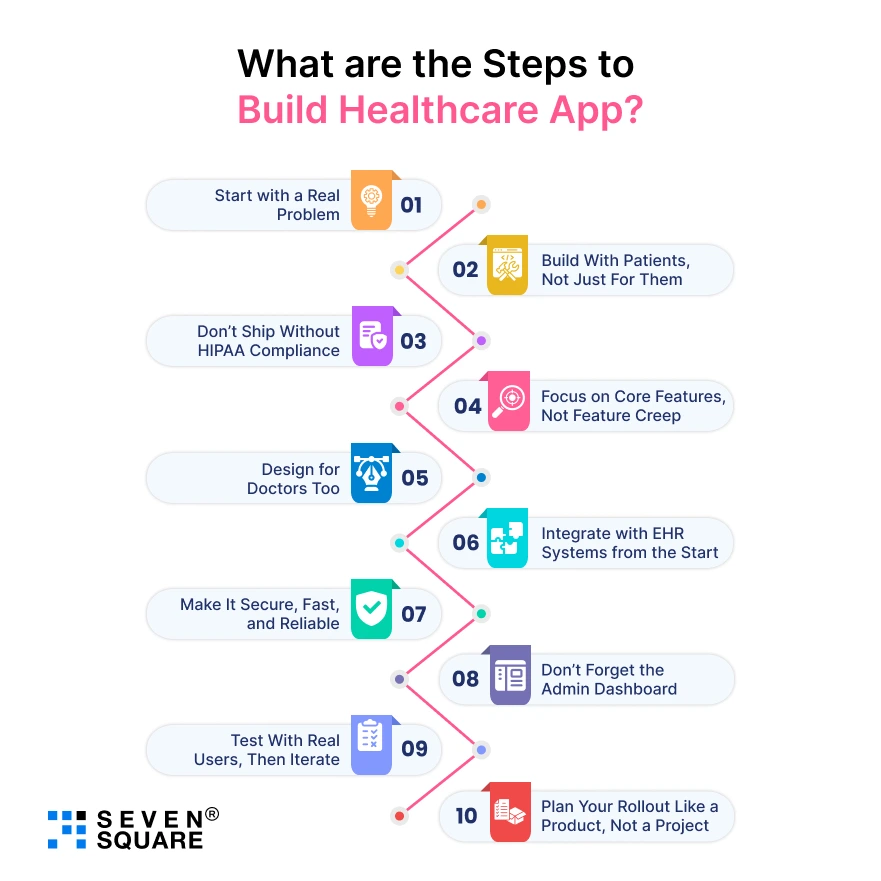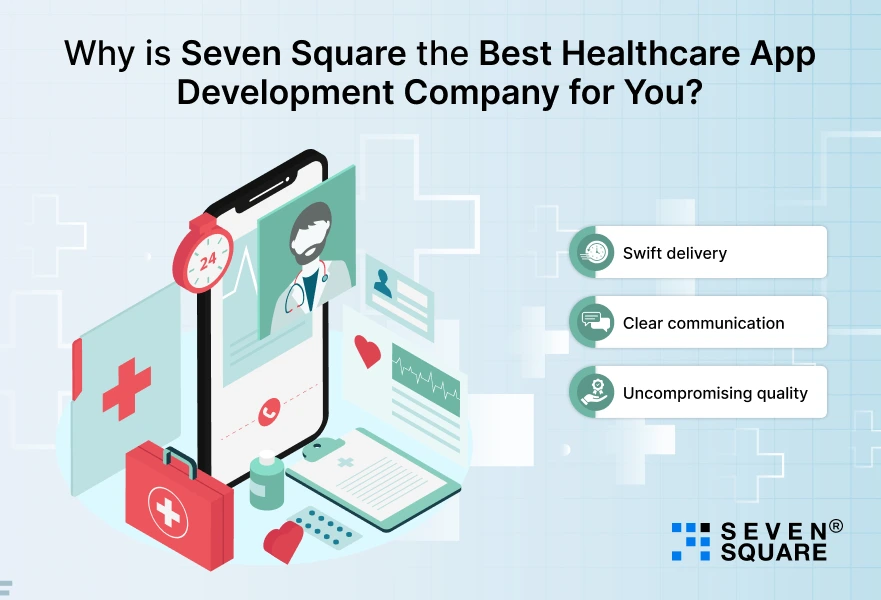Imagine this: You’re in the middle of launching a healthcare product.
You’ve got doctors onboard, a strong use case, and maybe even a bit of funding.
But the app, your main product, is barely usable.
Patients drop off during onboarding in your healthcare app.
Doctors complain about the UI. Nothing feels intuitive. And worst of all, users just don’t trust it.
We’ve worked with founders, healthcare professionals, and even hospital chains who came to us after trying and failing to build a healthcare app users love.
The tech wasn’t the problem. The problem was thinking that building a healthcare app is like building any other app. It’s not.
Trying to learn about healthcare app development services?
You are at the right place.
In this blog, you can learn how a healthcare app development company build healthcare mobile app according to your goals.
Why Building a Healthcare App Isn’t Just Another Dev Project?
Building a healthcare mobile app isn’t like creating a food delivery app or a travel planner. There are real lives and sensitive data at stake.
It’s not just about flashy UI: it’s about building trust, accessibility, and compliance from the ground up.
From our experience delivering custom digital health solutions and providing comprehensive healthcare app development services, here’s what separates a successful medical app from one that fizzles out:
- Patients want clarity and speed.
- Doctors need smooth integration with EHR systems.
- Everyone expects data security and reliability.
These aren’t just feature requests, they’re the baseline.
What are the Steps to Build Healthcare App?

Here you can explore the steps for healthcare app development and build the best healthcare app.
Step 1: Start with a Real Problem (Not Just an Idea)
We always ask our clients: What pain are you solving? If you can’t answer this without buzzwords, pause and reframe.
Some examples:
- “I want to reduce missed appointments through better scheduling.”
- “I want elderly patients to easily order medicine via voice commands.”
- “I want rural clinics to access specialists via telemedicine.”
This is where healthcare UX design and effective healthcare app design start, at the problem, not the solution.
Step 2: Build With Patients, Not Just For Them
If you’re not talking to patients while designing your user-friendly medical app, you’re designing blind. Real users will tell you where the friction is.
Whether it’s font sizes, button placements, or onboarding flows, patients, especially older ones have different expectations than your average tech user.
Some proven patterns:
- High-contrast buttons
- Clear primary CTAs
- Large, readable text
- One action per screen
We once redesigned a patient engagement app that had a 67% drop-off on the profile creation screen.
Why? Users didn’t understand why the app needed their insurance info upfront.
A simple tooltip and an FAQ link increased completion by 44%.
Step 3: Don’t Ship Without HIPAA Compliance
If your app handles protected health information (PHI), you need HIPAA compliance. That’s non-negotiable.
You can’t just “add it later.” Security has to be baked into the architecture.
Some things to cover:
- Encrypted data at rest and in transit
- Secure user authentication
- Regular access audits
- Role-based permissions
We built a HIPAA-compliant app for a US-based clinic group that included secure messaging, real-time alerts, and file uploads without sacrificing speed or usability.
Step 4: Focus on Core Features, Not Feature Creep
A good mHealth app development plan doesn’t start with 25 features. It starts with 3 killer ones. Ask yourself:
- What’s the single biggest value we provide?
- What workflows can we automate?
- What saves time for doctors and patients?
Most of our successful healthcare app development projects started with just a few core features: scheduling, messaging, and prescription tracking.
From there, you can expand to:
- Wearable integration
- In-app teleconsultation
- Medication reminders
- Health record exports
Step 5: Design for Doctors Too (They’re Power Users)
While you’re trying to wow patients, don’t forget the other half of your user base, healthcare providers.
Doctors are the power users of your medical app development. They need:
- Fast login and navigation
- Access to patient history
- Easy documentation tools
We created a telemedicine app that let doctors finish case notes 40% faster because the UI was built around their real workflow, not just pretty buttons.
Step 6: Integrate with EHR Systems from the Start
Modern healthcare doesn’t happen in silos. Your app should talk to hospital systems, not operate like an island.
This is where integrating EHR systems into healthcare apps becomes critical.
We’ve integrated everything from HL7 to FHIR APIs depending on the client’s stack. One thing we always say: Plan for integration before you write your first line of code.
Step 7: Make It Secure, Fast, and Reliable
Yes, we’re engineers. But we think like product builders. That means we focus on things like uptime, encryption, and backups just as much as clean UI.
A healthcare app should be:
- Fast (less than 2s load time)
- Reliable (99.9% uptime)
- Secure (end-to-end encryption)
Security isn’t just for compliance, it builds trust. And trust is what keeps users coming back.
Step 8: Don’t Forget the Admin Dashboard
Admins need to manage users, update records, and generate reports. A smart, scalable backend is just as important as the app interface.
In our healthcare app development projects, we always deliver a powerful admin panel that balances security and usability.
Step 9: Test With Real Users, Then Iterate
The only way to know if your user-friendly medical app is user-friendly? Let real users test it.
We usually run closed beta tests with:
- Patients of different age groups
- Doctors across specializations
- Healthcare administrators
This gives us real-world feedback fast, and our team knows how to translate it into smart iterations quickly.
Step 10: Plan Your Rollout Like a Product, Not a Project
Many founders treat launch day like the finish line. It’s not. It’s the starting gun.
A great healthcare mobile app launch includes:
- Phased rollout (start with one clinic or region)
- Usage analytics tracking
- Feedback channels
- Ongoing support plan
What Does It Cost to Develop a Healthcare App?
Wondering about the real cost to develop a telemedicine app or healthcare mobile app? Here’s the honest answer: it depends.
But here’s a rough range based on what we’ve shipped:
- MVP with core features: $3K to $5K
- Scalable product with integrations: $8K to $12K
- Full-scale, compliant, enterprise-ready app: $15K+
Why is Seven Square the Best Healthcare App Development Company for You?

We’re not just developers, we’re a team of engineers, designers, and product thinkers.
We’ve delivered custom healthcare app solutions for startups, clinics, and hospitals alike.
As a healthcare app development company, we bring deep domain experience into every build.
What sets us apart:
- Swift delivery (weeks, not quarters)
- Clear communication (no black boxes)
- Uncompromising quality (we don’t ship what we wouldn’t use)
We ensure you’re not just building a working app, you’re launching something that works, scales, and gets adopted.
Think Beyond the App
At the end of the day, building a healthcare app that users love is about more than code. It’s about empathy, reliability, and trust.
The ones users love are those who anticipate needs, reduce friction and respect their time and trust.
If you’re serious to build a healthcare app that users return to, rely on, and recommend, start with the user, build for clarity, and partner with a team that gets it.
FAQs
- Healthcare app development includes creating digital solutions specifically for patients, doctors, clinics, and hospitals.
- Unlike general app development, it requires HIPAA compliance, robust data security, integration with EHR systems, and UX tailored for medical use cases.
- It requires precision, trust, and a user-friendly medical app design that matches health data regulations.
- Key features include appointment booking, secure messaging, digital prescriptions, real-time notifications, patient history access, and integration with wearable devices.
- A well-designed healthcare app balances functionality with ease of use, especially for elderly patients or those unfamiliar with tech.
- A successful healthcare app design is clean, accessible, and patient-first. It should have readable fonts, intuitive navigation, helpful tooltips, and minimal friction during onboarding.
- Great design builds trust, especially in healthcare where sensitive data and high-stakes decisions are involved.
- Yes, Telemedicine is a growing segment in digital health.
- Features like video consultations, real-time chat, appointment scheduling, and e-prescriptions are core parts of modern telemedicine apps.
- A custom healthcare app development service can help you integrate these securely and flawlessly.